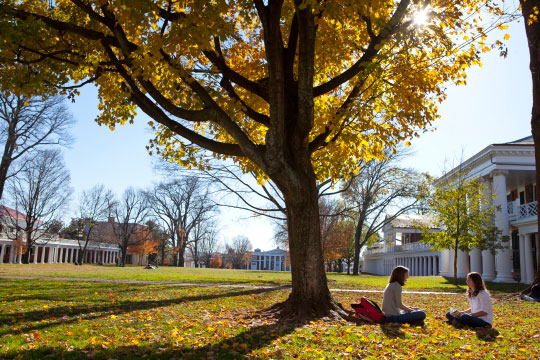The University of Virginia’s Lawn, the green space at the center of the Thomas Jefferson-designed Academical Village, has been named one of the 10 Great Public Spaces by the American Planning Association.
“It is nice to have national recognition for such a special place that is the heart of the University,” said Mary Hughes, landscape architect in the Office of the Architect for the University. “This is a national organization and it is an honor to be included with such places as Grand Central Terminal in New York City and Forest Park in St. Louis, which were announced last year.”
Each October during National Community Planning Month, the association’s “Great Places in America” program names 10 exemplary streets, 10 neighborhoods and 10 public spaces that add value to communities and foster economic growth. The Great Streets, Great Neighborhoods and Great Public Spaces feature unique and authentic characteristics that have evolved from years of thoughtful and deliberate planning by residents, community leaders and planners.
“Recognizing these special places highlights the role planning plays in adding value to communities,” William Anderson, president of the American Planning Association, said. “Planners, working with others, help build better communities in a variety of settings, from urban to rural. The result? Better neighborhoods, cities and regions. We applaud these efforts and congratulate this year’s designees.”
The association seeks spaces that balance the competing needs of different users; project a positive visual experience by incorporating activities mindful of the design; enhance the livability of the community; encourage human contact; and reflect the culture and history of its community.
“The Lawn is very special and it fosters a sense of community,” Hughes said. “That is part of its magic. There are no internal corridors, so everyone who walks through the Lawn is outdoors and the people who live there are outside and talking to their neighbors. The place is very conducive to having a conversation.”
Conversations aside, the Lawn is the center of community activities, such as the annual Lighting of the Lawn festival in December, Trick-or-Treating on the Lawn on Halloween, and the Opening Convocation in the fall and Final Exercises in the spring.
“The Lawn continues to be relevant as the emotional heart of the institution, and to be recognized as a great public place is important,” Hughes said.
As in Jefferson’s original vision, students and professors live together in the Academical Village, with the Lawn as their common outdoor space.
“The buildings are relatively low, and the Lawn was open to the south. It is not a traditional academic quadrangle,” Hughes said. “Jefferson clearly said he wanted a village, so he created a community of scholars and professors and students, with a central open community space – a common central green – and this magical thing continues to this day.”
Nearly 200 years after Jefferson envisioned it, the Lawn is still serving as the central green to his Grounds.
“The history of the Lawn has always been special,” Hughes said.
Media Contact
Article Information
September 30, 2014
/content/planners-group-designates-uva-s-lawn-great-public-space

